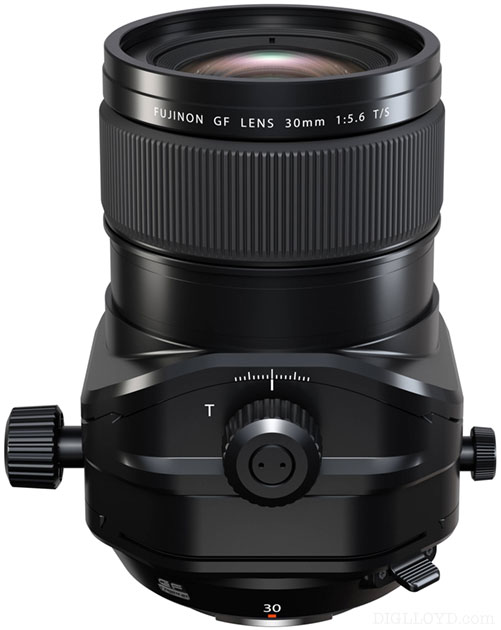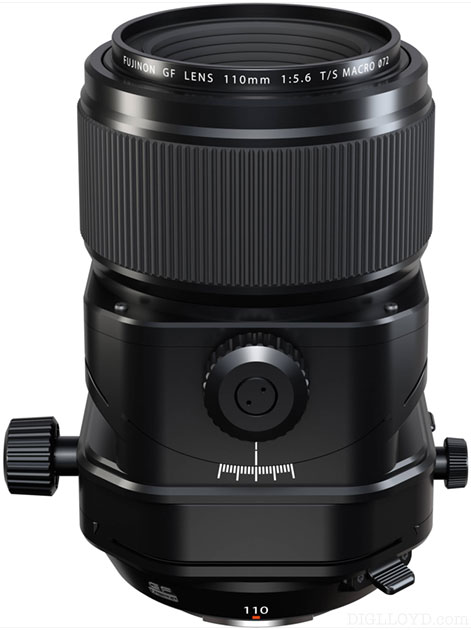Fujifilm GF 30mm f/5.6 TS and Fujifilm GF 110mm f/5.6 TS: How Useful are the Tilt/Shift Functions?
Announced today:
Fujifilm GFX100 II | Fujifilm GF 30mm f/5.6 TS | Fujifilm GF 110mm f/5.6 TS | Fujifilm GF 55mm f/1.7 WR.
It’s terrific to have tilt/shift lens options for the Fujifilm medium format platform.

A tilt lens alters the plane of focus relative to the plane of the sensor. With the right subject matter, it affords a massive increase in depth of field that the same aperture would rapidly blur without tilt. A desert playa stretching away, the wall of a building, etc. Such clean-cut applications are rare.
One significant downside of a tilt lens is that zeroing the tilt almost always induces a small but noticeable misalignment; it is after all a mechanical device. We might be talkking only 50 or 100 microns left/right or up/down, but that’s ample to blur one side. A lot depends on build quality, and what happens over time mechanically.
When to use tilt?
Rather, a tilt lens is a great tool for tabletop/product photography, special effects and other specialty situations.
But contrary to common assumptions, landscape shots rarely benefit from tilt (95% inapplicable?) because there is almost always something out-of-plane (eg trees, topography, etc), and stopping down remains very inadequate, tilt or no tilt.
For example, tilt is useless or nearly so in this landscape scene, where both the lake surface and the mountains must be sharp—divergent planes of focus are required and f/9 is not going to get the job done.
The foregoing is why I gave up on tilt lenses on the 35mm format and it’s even more of an issue on medium format. Focus stacking is almost always required for serious depth of field, tilt or no tilt. That said, a small tilt along with focus stacking is certainly a plus. Except that as a manual focus lens, no automated focus stacking via Focus BKT is possible. Thus the combination of tilt and focus stacking is IMO a non-starter in a practical sense for field work, since I cannot do focus stacking manually on medium format without a very high risk of “gapping” some frames—it’s gotta be automated. And it’s far too slow and tedious.
In short, tilt is rarely useful for landscape photography on ultra high resolution cameras such as the Fujifilm GFX100S II. And when automatic focus bracketing is eliminated, I just don’t see any value for that purpose, exceptions exist of course.
Stitched images via shift
More to my interest for landscape is the shift capability along with the tripod mount of the 30mm f/5.6, which allows shifting the lens to take a left/center/right image, then assembling them into one seamless image, all without any change to the entrance pupil position so that zero parallax is seen.
Potential: 3-shot 168-megapixel images without any rotational stitching involved.
However (and this is a serious concern), that presumes a stable tripod collar with no movement so that things line up exactly.... good luck with that in field conditions, which I say based on past experience. Until I try it, including in windy conditions, I have no verdict to render. It also depends on the build quality eg how operating the shift mechanism does to alignment; it doesn’t take much to twist the whole rig just slightly.
Why is there no tripod mount for the 110mm?
Thank you for buying using links on this site which helps both me and B&H Photo, which generously provides the loaner cameras and lenses.
Fujifilm GF 30mm f/5.6 TS
Looks like Fujifilm has done things right, including a tripod mount for the 30mm:
- f/5.6 to f/32
- 24.6mm Full-Frame Equivalent
- Built-In Data-Recording Sensor
- Maximum Tilt: +/- 8.5°
- Maximum Shift: +/- 15mm
- Mount Rotation: +/- 90°
- 1 x Aspherical Element
- 1 x Super ED and 2 x ED Elements
- Tripod Mount
- Built-in sensor records the level of shift and rotation and embeds that information into the metadata.
Fujifilm GF 110mm f/5.6 TS
Why no tripod mount for the 110mm? That makes it impossible to maintain perspective for stitching images.
- Medium Format | f/5.6 to f/32
- 87mm (Full-Frame Equivalent)
- Telephoto Macro Lens
- Built-In Data-Recording Sensor
- Maximum Tilt: +/-10°
- Maximum Shift: +/-15mm
- Mount Rotation: +/-90°
- 1 x Aspherical, 2 x ED Elements
- 1:2 Magnification, 16" Minimum Focus
- Built-in sensor records the level of shift and rotation and embeds that information into the metadata.
Fujifilm launches “FUJINON Lens GF30mmF5.6 T/S” and “FUJINON Lens GF110mmF5.6 T/S Macro
September 12, 2023
Long-awaited tilt-and-shift lenses for the GFX Series of mirrorless digital cameras
TOKYO, September 12, 2023 – FUJIFILM Corporation (President & CEO, Representative Director: Teiichi Goto) announces the release of the tilt-and-shift lens “FUJINON Lens GF30mmF5.6 T/S” (GF30mmF5.6 T/S) in October 2023, and the tilt-and-shift macro lens “FUJINON Lens GF110mmF5.6 T/S Macro” (GF110mmF5.6 T/S Macro) in November 2023.
The new lenses join the lineup of GF lenses, i.e. interchangeable lenses for the GFX Series of Fujifilm’s mirrorless digital cameras equipped with the large-format sensor*1 measuring approximately 1.7 times that of the 35mm full-frame sensor.
The GF30mmF5.6 T/S and GF110mmF5.6 T/S Macro combine the tilt function of tiling their optical axis and the shift function of moving their optical axis in parallel to alter how the optical axis relates to the imaging plane and intentionally manipulate areas in focus and perspective. This caters to the needs of professional photographers who want to explore composition and shooting positions freely in architecture, landscape and commercial photography, broadening the range of shooting that takes advantage of GFX Series’ superior image quality.
The GF30mmF5.6 T/S is a wide-angle tilt-and-shift lens with the focal length of 30mm (equivalent to 24mm in the 35mm film format). It suppresses distortion and ghosting, typically seen with wide-angle lenses, to achieve a high level of image resolution. Users can keep everything within the frame in focus in landscape photography from grass in the foreground to distant mountains, or correct distortion characteristically seen in architectural photography when shooting tall architectures.
The GF110mmF5.6 T/S Macro is a mid-telephoto tilt-and-shift macro lens with the focal length of 110mm (equivalent to 87mm in the 35mm film format) and maximum reproduction rate of 0.5x. It suppresses various types of aberration to achieve an advanced level of image resolution. The focal position of a subject in close-up can be controlled freely to meet the needs of commercial photography for still life, etc.
*1 An image sensor that measures 55mm diagonally (43.8mm x 32.9mm) and is approximately 1.7 times larger than a 35mm full-frame sensor
 Fujifilm GF 30mm f/5.6 TS
Fujifilm GF 30mm f/5.6 TS(1) Wide-angle tilt-and-shift lens “FUJINON Lens GF30mmF5.6 T/S”
(1) Advanced optical design that delivers superior image resolving performance
The lens consists of 16 lens elements in 11 groups including three aspherical lenses, two ED lenses and one Super ED lens. Its generous configuration featuring the use of a large-diameter aspherical lens as the front element as well as three ED lenses provides advanced optical design that eliminates the need for electronically correcting distortion and lateral chromatic aberration. Spherical aberration, comatic aberration and field curvature are suppressed to the extreme extent to achieve edge-to-edge sharpness even during shifting.
The use of Fujifilm’s proprietary Nano GI Coating technology controls refractive index on the lens surface moderately to inhibit unnecessary light reflection and reduce ghosting and flare, which are typically seen in wide-angle lenses.(2) Tilting and shifting mechanisms that make most of the benefits of the large-format sensor
Tiling of ±8.5° and shifting of up to ±15mm control the focal plane and perspective of the subject. The revolving operation of changing tilting and shifting directions within ±90° is combined with the T/S revolving operation, where the angle of tilting and shifting direction can be adjusted from perpendicular to parallel within 0°〜90° to give a high level of shooting freedom.
The lens has a built-in sensor that detects the degree of shifting and revolving movements. This data can be checked in Live View and is recorded into image data so that it can be referred to during RAW processing*2.
(3) Compact design that considers ease of use during shooting
Wide-angle tilt-and-shift lenses tend to become large. However, the positioning of lens elements has been optimized to achieve a compact design measuring just 138.5mm and weighing 1,340g. Furthermore, the filter thread size is a versatile 105mm*3, allowing users to use a variety of filters to suit wide-angle situations including landscape.
The lens comes with a tripod collar, specifically designed for it. Even during shifting, the collar helps maintain the subject’s position in relation to the lens to prevent parallax and facilitates accurate stitching of multiple images. Fujifilm GF 110mm f/5.6 TS
Fujifilm GF 110mm f/5.6 TS(2) Mid-telephoto tilt-and-shift lens “FUJINON Lens GF110mmF5.6 T/S Macro”
(1) Advanced optical design that produces superior image sharpness
- This lens consists of 11 lens elements in nine groups including one aspherical lens and two ED lenses. The aspherical lens controls comatic aberration and field curvature while the ED lenses minimize axial chromatic aberration to the extreme extent. Furthermore, the lens configuration, symmetrical with the aperture midway, suppresses distortion and lateral chromatic aberration to achieve edge-to-edge sharpness without relying on electronic correction.
- This lens achieves the maximum magnification ratio of 0.5x for close-up photography. Users can enjoy unconstrained focal control while going up close to the subject, a feature useful in commercial photography for subjects such as still life.
(2) Tilting and shifting mechanisms that make most of the benefits of the large-format sensor
Tilting of ±10° and shifting of up to ±15mm control the focal plane and perspective of the subject. The revolving operation of changing tilting and shifting directions within ±90° is combined with the T/S revolving operation, where the angle of tilting and shifting direction can be adjusted from perpendicular to parallel within 0°〜90° to give a high level of shooting freedom. The lens has a built-in sensor that detects the degree of shifting and revolving movements. This data can be checked in Live View and is recorded into image data so that it can be used during RAW processing*2.
(3) Compact design that reduces the burden during shooting
This lens measures 149mm and weighs 1,255g with the filter thread size of 72mm. It uses a focus system that extends out in order to keep the overall lens size compact.
Close attention has been paid to designs of operation sections to achieve a highly functional design that reduces users’ burden during extended shooting.
























